Electric Water Heaters
Purchasing Hot Water Heater Elements
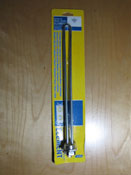 If you have determined that your water heate elements are bad, you are going to need to purchase new ones. There are a few things to keep in mind before you run to the hardware store or order online.
If you have determined that your water heate elements are bad, you are going to need to purchase new ones. There are a few things to keep in mind before you run to the hardware store or order online.
Not sure if your elements are bad? See the article, 'Electric Water Heater Element Testing' for information on how to check the elements.
Not sure if the elements are even the problem? See 'Troubleshooting Electric Water Heaters' or 'Gas Water Heater Troubleshooting' for a complete listing of problems and solutions.
Types of Hot Water Heater Elements
There are both 'high density' and 'low density' hot water heater elements. Low density elements are considered better, they last longer and are less prone to build up. The low density elements have more surface area and therefore do not need to get as hot.
Density has to do with the surface are of the heating element. Low density elements have more surface area. They are also coated and/or made from different materials to resist corrosion.
Low Density Elements
This type of element is made from copper with a magnesium oxide and nickel coating. This type of element provides more heating surface and is less prone to corrosion. Low density elements are a little more expensive than high density types. This style will have a screw type fitting to install it.
High Density Elements
This type is the least expensive and will likely be he type installed originally in your water heater. This type will come in either a screw type or flange type connection. High density elements are the most suceptible to corrosion and failure due to the high heat generated. This type is made from copper and may have a zinc coating.
Extra Low Density Elements
This type is the best element that you can get. Some of them come with a lifetime gaurantee. They are made from high grade stainless steel. They are less prone to build up and will not burn out. These are also the most expensive elements.
You may have trouble finding a low density element with a flange assembly. You can purchase an adapter kit to use a screw in type on a flanged set up. It's up to you. For a screw type element you should not have a problem finding either density. Of course the low density elements cost more. Did you think you would get something for nothing? It's not a lot, a few dollars more for the better one. Make your choice on the density thing, use the salesman in you need to. After that you are ready to get things back together.
Water Heater Element Wattage
The wattage on hot water heater elements can range from 1500 to 5500 watts. Wattage is determined by voltage so you want to match the voltage and wattage for your new elements.
The best place to find the wattage and voltage information is on the label that is attached to the side. You will usually see two wattage numbers for each element. A lower number and a higher one. The reason for this is the acceptable voltage range that the water heater will operate at.
Most homes in the United States are wired for 120/240 Volts, but the voltage can go as low as 208 volts. Since wattage is based on voltage, the lower number you see on the label is based on the minimum voltage requirement.
There may be a 'Total Connected Wattage' number on the label. If it matches the wattage for the individual elements it means that only one element at a time will heat on the water heater.
Heating Element Attachment Types
There are two types of attachment types for electric water heater elements. Most newer water heaters are threaded and screw into the side of the tank. You need a large wrench to remove and install this type.
Older water heaters may have a flange type element. The bolts are smaller, but there are more of them, usually four. Before you purchase new elements yuo want to make sure that you have the correct flange for your water heater.
What Is the Next Step?
If you are purchasing water heater elements you will likely need to install them. See the article on 'Installing Electric Water Heater Elements' for complete instructions.
This job will require that you shut down and drain the water heater. See 'Shutting Down and Electric Water Heater' for information on what is involved.
Testing Water Heater Element Continuity
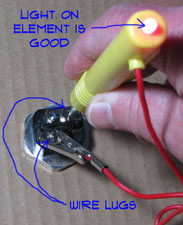 Testing a water heater element for continuity is fairly simple when you have the right tester. If power is not going through the element, it will not heat. No heat, no hot water, simple.
Testing a water heater element for continuity is fairly simple when you have the right tester. If power is not going through the element, it will not heat. No heat, no hot water, simple.
Not sure if this is the right place? See 'Troubleshooting for Electric Water Heaters' or 'Gas Water Heater Troubleshooting' for all of the water heater problems and resources.
What Is Continuity
Simply put, continuity is the ability of the wire or element to complete an electrical circuit. Electricity needs a continuous path to work. Any break or interuption will cause it to fail.
For a hot water heater, the elements are submerged in water constantly. The repeatedly heated to heat the water in the tank. Over time they deteriorate and corrode. When this happens they may lose the ability to carry an electrical current. A simple test will tell you whether or not they are still viable heating elements.
Getting the Right Tester
There are lots of fancy testers out there that can cost quite a bit of money. For this test, you just need a simple continuity tester. All it does is run an electrical charge through the element. If the current goes through and gets back to the tester, it lights up.
A continuity tester is different from a voltage tester. A voltage tester relies on the power in the wires to work. Wheras a continuity tester provides its own current via a battery. You can purchase a continuity tester for $10 to $15 at a home supply store or online.
It shold have a single lead that connects to a pen like tool that has a contact on it and a small light. The lead will have a clip on it that can attach to an electrical terminal.
NOTE: The tests noted below can also be done with a multi meter. Multi meters are a little tricky to use and beyond the scope of this article. Check out Using a Multi meter, for more information.
Testing the Element
Shutting Down the Water Heater
The first thing you want to do is turn off the power. Shut off the breaker and tag it so that no one turns it back on. Water heater element testing should only be done when the power is off.
It is very important to make sure the power is off. See the article on 'Shutting Down an Electric Water Heater' for more information. If you elements do turn out to be bad, you are going to have to follow all of the shut down steps.
Accessing Electric Water Heater Elements
An electric water heater has two elements, an upper and a lower. There are cover plates on the outside of the tank that are held in place by a couple of screws. Remove the cover plates to get to the element ends and the thermostats.
There may be some insulation that needs to be pushed back out of the way. See the picture to help you identify the element.
Performing the Continuity Test
Before you begin, you want to make sure your tester is working. Touch the leads together to make sure it is working. They have a light on them that should glow or light up when you touch the leads. If the tester fails to light up you will probably need to replace the batteries. If batteries don't help, you will need to get another tester.
One last safety check, use a voltage tester to double check that the power is off.
There are two terminals on the element. To test for continuity, attach the clip to one of the terminals, no it does not matter which one. Touch the lead to the other terminal. The light on your tester should light up or buzz depending on the tester that you have. If it does, your element is still able to accept electrical current.
The Element Passed - Next Steps
Passing this test does not necessarily mean that you are out of the woods. Obviously, you are here because you either don't have enough hot water or you have no hot water. So, if the element passed the continuity test, there is still something wrong.
You will also need to test and see if you element is grounding out. See the article, 'Testing a Water Heater Element for Ground'. This is another simple test that determines whether or not the insulation on the element is still intact. If the element grounds out, it will not work.
What If the Test Fails?
If the test fails, the element is bad and will need to be replaced. There are no other choices, they cannot be repaired and there are no moving parts.
You need to test both elements to see if they are both bad. Perform the continuity test on the other element to see if it is working.
Replacing the Elements
What If Only One Element Failed?
New elements will cost between $15 and $40, so there is a cost consideration when only one is bad.
With that said, there is some common sense to be applied here. If only one element has gone bad it is very likely that the other one is not far behind. There is a fair amount of work involved to change one element. It makes sense to replace both of them at the same time.
Purchasing and Installing Elements
Replacing the elements is a job that requires draining the tank. You will want to see the article 'Installing Electric Water Heater Elements' for complete instructions on performing.
Wiring an Electric Hot Water Heater
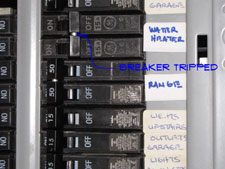 Why would wiring an electric water heater be something you would even think about attempting? To troubleshoot an electric water heater, you need to understand how the wiring works. There are safety concerns to be aware of. Are you willing to take a little time and become familiar with this type of problem? Will you follow the safety guidelines? This information will help you by providing a general knowledge of your electric water heater.
Why would wiring an electric water heater be something you would even think about attempting? To troubleshoot an electric water heater, you need to understand how the wiring works. There are safety concerns to be aware of. Are you willing to take a little time and become familiar with this type of problem? Will you follow the safety guidelines? This information will help you by providing a general knowledge of your electric water heater.
Did you answer yes to the two questions above? Yes, then you are allowed to continue reading. Safety when it comes to an electrical repair cannot be stressed enough. Serious injury and even death can result from an electrical shock. I am not even thinking about inserting something humorous here. Electric hot water heaters use 240 volt with significant amperage. More than enough to kill someone. Are you sufficiently afraid, actually respect is the correct word. You always need to have a respect for electricity when you work around it.
After this second warning are you still willing to proceed? Did you answer yes? How about a third warning, never touch anything on your hot water heater unless you are absolutely sure that the power is off. Use a tester to make sure.
Using Common Sense Header
What Can You Save?
Getting someone to come out to your home involves the proverbial 'service call'. This the fee that you pay for the privilege of meeting the serviceman. Prices vary, but the is usually $50 to $85. For a simple problem this will take care of it. With a water heater you may be faced with up selling. "Yes, i can fix it, but it may not last" might be the comment. Suddenly you are faced with a replacement project, maybe $500 to a $1,000. Whoa, at least make yourself familiar with your situation before you proceed. Make the repairman describe exactly what the problem is. Be armed with good questions.
How Hard Could It Be?
Wiring an electric water heater is an above average repair task. You have both skill issues and safety issues.
For and explanation of the terms in this section, see How to Use This Site.
Check the Simple Things!
Check the breaker. No hot water? Is the breaker tripped? Unfortunately, a tripped breaker may be indicative of a more serious problem. Electric hot water heaters also have reset buttons (see below). Again bad news, if the reset trips it usually means something more serious is wrong.
What Can Go Wrong?
Did you read the beginning of this article? You have some very serious power going through your electric water heater. Be safe, take precautions. Water is also involved. Draining down a tank or flushing a tank will involve water, be prepared.
Understanding Electric Water Heater Wiring
Most hot water heaters are on a 30 amp two pole breaker. The two poles means it is a stated 240 volts or an actual 230 volts. As long as your water heater is not too far from the panel it will be wired with #10 wire. This is the common format for wiring an electric water heater, but it is not the only one.
Some newer two element tanks give you an option for simultaneous operation. What? In years gone by most electric water heaters with two elements were factory wired so that only one element would heat at a time. The upper thermostat would keep track of this, only allowing the lower element to heat when the upper one was finished. This is why electric water heaters have a longer recovery time than gas.
Now there is the option of wiring a hot water heater so the both elements run at the same time. This reduces the recovery time and will provide more hot water. The trade off it that it uses more amps and requires heavier wire.
Wiring an electric water heater with simultaneous element operation will mean a 45 Amp breaker and #6 wire. In a house that was wired any length of time back you probably don't have the right wiring for this configuration, even if you get a new hot water tank. You always want to check local codes before modifying any wiring in your home.
Hooking up the Wires
So how many wires do you get anyway? Wiring an electric water heater does not require that you use a plug in device. Therefore an extra conductor is not required. Most water heaters are wired with 10-2 w/Ground shielded cable. For long distances you may need to go with heavier wire. When you use this type of wire both the white and the black will serve as hot conductors. The bare ground wire will also be connected to the neutral lug.
Shielded metallic cable should be used from the water heater to the wall or ceiling. There will be an adapter connected to the top of the tank and the shielded cable will continue until it is out of the area where the wiring might be damaged.
You may find that a cable with an extra conductor has been used. This would be 10-3 w/Ground. In this case the red and the black wire will be used as the hot leads. You now have an redundancy with the ground and the white wire. The white wire is not needed. The long and the short of this story is that a water heater needs two hot conductors and a ground to work.
I have not mentioned 120 volt electric water heaters up to this point. For a residence they are highly impractical. They cost a lot to run and will not produce enough hot water to satisfy the needs of a home.
Checking for Power
The first thing you want to do is make sure that you are getting power to your electric water heater. See if the breaker has been tripped in the panel. Has it tripped? Yes, this is sort of good news. Reset the breaker and see if it holds. This could be a sign of another problem.
The next logical step would be to see if you have power to the water heater. The wiring is located on the top of the water heater. Before you take the cover off, shut the power off. Make sure that the power is off with the non contact voltage tester. Separate the wires enough to test the individual conductors.
Turn the power back on and use a non-contact tester to see if you are getting power to the water heater. The indicator light should light up when you are near a hot conductor. You should have two hot conductors coming into your electric water heater.
WARNING!! Make Sure the Power is OFF!!! BEFORE You Work on Electrical Devices!!!
Checking the Reset Button
There are two covers on the side of your electric hot water tank. Wiring and electric hot water heater also includes the high limit reset buttons. When they trip the water will not heat up.
The first thing you do is to shut off the power. After that there are two covers on the side of the hot water tank. Remove the covers, the insulation and the plastic shields. Make sure the power is off by using a working voltage tester. The upper and possibly the lower thermostats will have a red reset button. They pop out when they trip.
After you reset them you can put the covers on and turn on the power. If they keep tripping, something else is wrong, either with the thermostats or the elements. See Hot Water Heater Element Testing for information on how to check the components.
Checking the Heating Elements
The water heater elements do the actual work of heating the water. You likely have two of them. They are also the likely candidate when troubles arise. One or both elements can go bad. When the upper element goes bad you have no hot water. When the lower element fails you will have minimal hot water. So the elements are a big part of wiring an electric water heater.You can use a simple test to tell if the elements are bad. See the article Hot Water Heater Element Testing for instructions on how to check them. The article Repairing Hot Water Heater Elements has information on replacing them.
Sediment build up can cause the lower element to fail repeatedly. See Hot Water Heater Sediment for information on build up in your water tank.
Checking the Thermostats
Wiring an electric water heater also includes the thermostats. The thermostats tell the elements when to heat up. Most residential water heaters have an upper and a lower thermostat. These are usually set up for non-simultaneous operation. Meaning that only one element is allowed to heat at a time. The upper thermostat acts as the controller, allowing first the upper element to heat and then the lower element.
A bad upper thermostat will mean no hot water at all. When the lower thermostat acts up you will have hot water, just not very much. The upper thermostat will always have a reset button. Sometimes the lower one will have one to. This is a red button that pops when the thermostat overheats.
The thermostats also have temperature settings on them. Hot water heaters are set at the factory to 120 degrees. Any hotter than that and you run the risk of serious burns. Homes with elderly, handicapped or children should not have the temperature set above this level.
To find out if your thermostats are bad, you need to test them. See the article Hot Water Heater Element Testing for instructions on how to test them. For instructions on replacing the thermostats, see Repairing Electric Water Heater Thermostats for all the information you need.
Wiring an Electric Water Heater Summary
Were you able to figure out what your problem is? Wiring an electric water heater involves several electrical components. Since you have so many items involved it takes some investigating to locate your problem.
In this article you found some general information about how an electric hot water heater works. It could be that your problem was in the wiring. You were also directed to other resources that discuss the various components. The hot water heater elements are the hands down winners for be troublesome. Your wiring an electric water heater problem may have involved changing the elements. Hopefully you have found your problem and are now enjoying plenty of hot water.
Testing Water Heater Thermostats
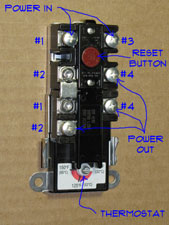 Testing water heater thermostats is important in locating water heater problems. The upper thermostat controls both the upper and lower element. When it goes bad you don't have any hot water at all.
Testing water heater thermostats is important in locating water heater problems. The upper thermostat controls both the upper and lower element. When it goes bad you don't have any hot water at all.
This article deals with 'Thermostats' on Electric Water Heaters. For thermostats on Gas Hot Water Heaters you will need to see the article 'Gas Water Heater Thermostats' for more information.
Not sure if this is your problem? See 'Troubleshooting Electric Hot Water Heaters' or 'Water Heater Element Testing' for other related topics.
The lower thermostat just controls the lower element. When the upper element works and the lower one does not you have a low supply of hot water.
The thermostats are less likely to be at fault than the elements. However they do go bad and testing water heater thermostats is still required. Your water heater usually has two elements and two thermostats.
The upper thermostat has two functions. First it allows the upper element to heat the water in the top of the tank. When this water is hot enough it shuts the upper element off. Then it allows power to go to the lower element.
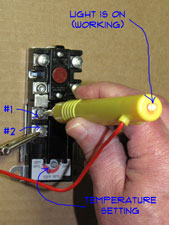 Make sure that the power is off. Turn the temperature to its highest setting on the upper element. This insures that the thermostat will call for heat. You want to use the water heater tester to check terminals #1 and #2 on the upper element (this will be the lower set of #1 and #2 terminals). You should get a glow or light if the contacts are engaging. No light, bummer, the thermostat is bad. See 'Replacing an Electric Water Heater Thermostat' for instructions on what to do.
Make sure that the power is off. Turn the temperature to its highest setting on the upper element. This insures that the thermostat will call for heat. You want to use the water heater tester to check terminals #1 and #2 on the upper element (this will be the lower set of #1 and #2 terminals). You should get a glow or light if the contacts are engaging. No light, bummer, the thermostat is bad. See 'Replacing an Electric Water Heater Thermostat' for instructions on what to do.
We are going to get into a weird area here. The next test depends on whether you have simultaneous or non-simultaneous element operation. What! Are you kidding? What does that mean? Most electric hot water heaters are non-simultaneous operation. Meaning that only one element heats at a time. Simultaneous means that both elements can heat at the same time.
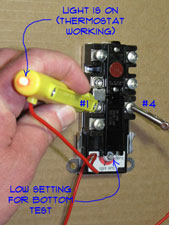 How do you tell the difference? First simultaneous operation requires a bigger breaker and heavier wire. You will likely have a 45 or 50 amp breaker for your hot water heater. Non-simultaneous will only have a 30 amp breaker. Second a non-simultaneous water heater will have a lower #4 terminal on the upper thermostat. Simultaneous operation will not have the second #4 terminal. Is the water heater element testing thing confusing or what?
How do you tell the difference? First simultaneous operation requires a bigger breaker and heavier wire. You will likely have a 45 or 50 amp breaker for your hot water heater. Non-simultaneous will only have a 30 amp breaker. Second a non-simultaneous water heater will have a lower #4 terminal on the upper thermostat. Simultaneous operation will not have the second #4 terminal. Is the water heater element testing thing confusing or what?
Assuming that you have non-simultaneous operation, continue with this paragraph. Next you need to check the contacts that control the lower element. You want to set the temperature on the upper thermostat to it's lowest setting. Turn it until it clicks off. This should insure that upper element is not calling for heat. This will only work if the water in the tank is warm. With ice cold water the test will fail.
We are talking about process of elimination here. Is the upper element good? Do you have power to the elements and thermostats? The water is not heating? Replace the upper thermostat, see the link in the previous paragraph.
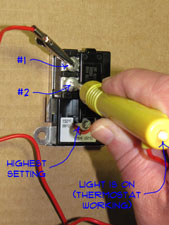
Use the tester on terminals #1 and #4 (remember, the lower #1 and #4). Again the light should come on or glow. No light, time for a new thermostat.
To check the lower thermostat you need the upper thermostat turned off. The lower thermostat needs to be turned to its highest setting. This should insure that lower thermostat is allowed to engage. Use the water heater tester to check terminals #1 and #2 (the lower set).
The whole simultaneous dissertation does not matter for this one (boy, what a relief). You should get a glow or a light if contact is made. No light, then the bottom thermostat is bad.
Summary
Electric water heater thermostats are a fairly simple devices that can fail from time to time. Testing is the only option if you want to determine whether or not one or both of them has failed.
If the thermostats are okay, you need to test the water heater elements. See 'Testing Electric Water Heater Elements' for more information.
Testing for Ground on Water Heater Elements
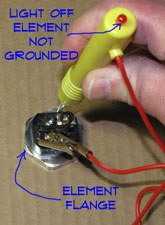 Testing for ground on water heater elements is a fairly simple test that only takes a few minutes. You should also 'test for continuity' at the same time. These tests require that you shut off the power to the water heater and remove the access panels.
Testing for ground on water heater elements is a fairly simple test that only takes a few minutes. You should also 'test for continuity' at the same time. These tests require that you shut off the power to the water heater and remove the access panels.
Not sure if this is the right place? See 'Troubleshooting for Electric Water Heaters' or 'Gas Water Heater Troubleshooting' for all of the water heater problems and resources.
What Does 'Testing for Ground' Mean?
Testing for ground on a water heater element is similar to 'testing for continuity'. However, the failure is completely different. The metal part of the heating element is kept separate from the metal in the tank by a plastic insulator. If this cracks or loosens, the water in the tank will cause it to short out.
If the current goes into the tank and back through the ground wire, the element fails to heat up and you don't have any hot water. So the term 'testing for ground' means to test and see if the element is grounding out into the metal on the tank.
Using the Right Tester
To check for ground you need to use a continuity tester. This is a battery operated tester that runs a small current through a device or wire to see if it is carrying electricity.
NOTE: This test can also be done with a multi meter. Multi meters are a little tricky to use and beyond the scope of this article. Check out Using a Multi meter, for more information.
You can purchase a simple water heater tester for around $10. This performs the same tests that you would use a multi meter for and it is a lot simpler to use. Do you already have a multi meter? Do you know how to use it? Great, you're all set.
Checking for Ground
Shutting Down the Power
The first thing you to do is make sure the power to the water heater is off. Go to the main panel and turn off the breaker for the Hot Water Heater, it should be marked on the legend.
It is very important to make sure the power is off. See the article on 'Shutting Down an Electric Water Heater' for more information. If you elements do turn out to be bad, you are going to have to follow all of the shut down steps.
Accessing the Water Heater Elements
An electric water heater has two elements, an upper and a lower. There are cover plates on the outside of the tank that are held in place by a couple of screws. Remove the cover plates to get to the element ends and the thermostats.
Typically the elements are below the thermostats. The upper thermostat will have a red reset button on it.There may be some insulation that needs to be pushed back out of the way. See the picture to help you identify the element.
Testing the Element for Ground
Checking ground on water heater elements if similar to testing the element. Make sure the power if off before beginning. Double check with a voltage tester.
Similar to Step One, the power needs to be off and the wires removed. Clamp one of the terminals to one of the lugs on the element. Touch the other lead to the metal element flange. This time no light is good.
If the light glows it means that the element is grounding out and needs to be replaced.
The Element Passed - Next Steps
Passing this test does not necessarily mean that you are out of the woods. Obviously, you are here because you either don't have enough hot water or you have no hot water. So, if the element passed the continuity test, there is still something wrong.
You will also need to test and see if you element is maintaining continuity. See the article, 'Testing a Water Heater Element for Continuity'. This is another simple test that determines whether or not the electrical current is passing through the element correctly. If power fails to go through the element, it will not heat up.
What If the Test Fails?
If the 'ground' test fails, the element is shorting out and will need to be replaced. There are no other options, elements cannot be repaired and there are no replaceable parts
You need to test both elements to see if they are both bad. Perform the 'ground' test on the other element to make sure it is not shorting out.
Replacing the Elements
What If Only One Element Failed?
New elements will cost between $15 and $40, so there is a cost consideration when only one is bad.
With that said, there is some common sense to be applied here. If only one element has gone bad it is very likely that the other one is not far behind. There is a fair amount of work involved to change one element. It makes sense to replace both of them at the same time.
Purchasing and Installing Elements
Replacing the elements is a job that requires draining the tank. You will want to see the article 'Installing Electric Water Heater Elements' for complete instructions on performing.


